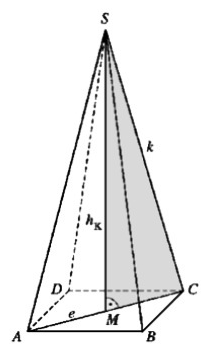Berechne das Volumen einer quadratischen Pyramide mit der Grundkante \( a \), der Höhe \( h_{\mathrm{K}} \), der Seitenkante \( k \) und der Diagonale \( e \) der Grundfläche.
a) \( a=5,2 \mathrm{~cm}, \quad k=9 \mathrm{~cm} \)
b) \( a=7,5 \mathrm{~cm}, \quad k=12,4 \mathrm{~cm} \)
c) \( e=6 \mathrm{~cm}, \quad k=10,6 \mathrm{~cm} \)
d) \( e=8,15 \mathrm{~m}, \quad k=15 \mathrm{~cm} \)
e) \( h_{\mathrm{K}}=8,2 \mathrm{cm}, \quad k=9,7 \mathrm{~cm} \)
f) \( h_{\mathrm{K}}=4,7 \mathrm{~cm}, \quad k=7,6 \mathrm{~cm} \)
